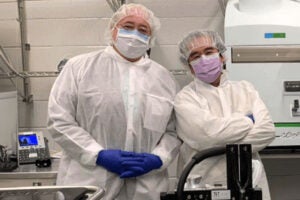Researchers at UCF’s College of Medicine who developed a new wound-healing technology report that their innovation may also be a promising treatment for Parkinson’s disease.

The technology developed by Frederick Carrick, professor of neurology at UCF’s College of Medicine, and Kiminobu Sugaya, professor of medicine and leader of the Neuroscience Division at the Burnett School of Biomedical Sciences, speeds healing through specially designed ceramics wrapped in a rubber blanket. When the UCF researchers used the ceramic far-field infrared (cFIR) blanket to treat a Parkinson’s disease patient’s non-healing wound, they found the technology also decreased his hand tremor and frozen gate.
Parkinson’s is the most common motor disorder and the second most frequently diagnosed neurodegenerative disease after Alzheimer’s disease. The tremor, rigidity, and slowness of movement associated with Parkinson’s affect up to 10 million people worldwide. Although there are drugs to treat Parkinson’s disease, they provide only temporary relief from the movement and tremors patients experience.
Carrick explained that the researchers used mice models that simulate Parkinson’s disease in humans. The team found that the models treated with the ceramics had much better control of their balance and movement. Excitingly, even normal healthy mice that were treated with the ceramics improved their balance and movement. Carrick stated that their investigation showed the treatment increased the number of brain cells in the areas of the brain associated with Parkinson’s disease. They also were able to increase the number of brain cells in normal healthy mice.
Sugaya stated that one of the benefits of using the ceramic blanket is that it can be used anywhere, without the need for a power supply and without the side effects commonly found when injecting chemicals or drugs. Because of that, the new ceramic blankets are ideally suited for use in combat situations or civilian applications in remote areas.
Because of their potential in treating combat injuries, the research is of interest to the military and the UCF abstracts are being published online and in supplements in the Journal of Military Medicine and the Journal of Trauma & Acute Care Surgery.
The (cFIR) blanket was developed by Gladiator Therapeutics, located in Whitehall, Pennslyvania. The UCF research team is conducting ongoing research on the use of the ceramic blanket in treating Alzheimer’s, Parkinson’s, traumatic brain injury and heart failure. They have recently developed a new Alzheimer’s therapy combining drugs affecting stem cells that increase the development of brain cells and improve brain function. They are also the first to transplant stem cells isolated from the human brain to aged rats where they showed increased development of new brain cells and improvement of cognition. Besides their research using the cFIR blanket, they are also working on developing a new treatment for glioblastoma multiforme (a type of brain cancer) using gene therapy with a unique delivery system.




